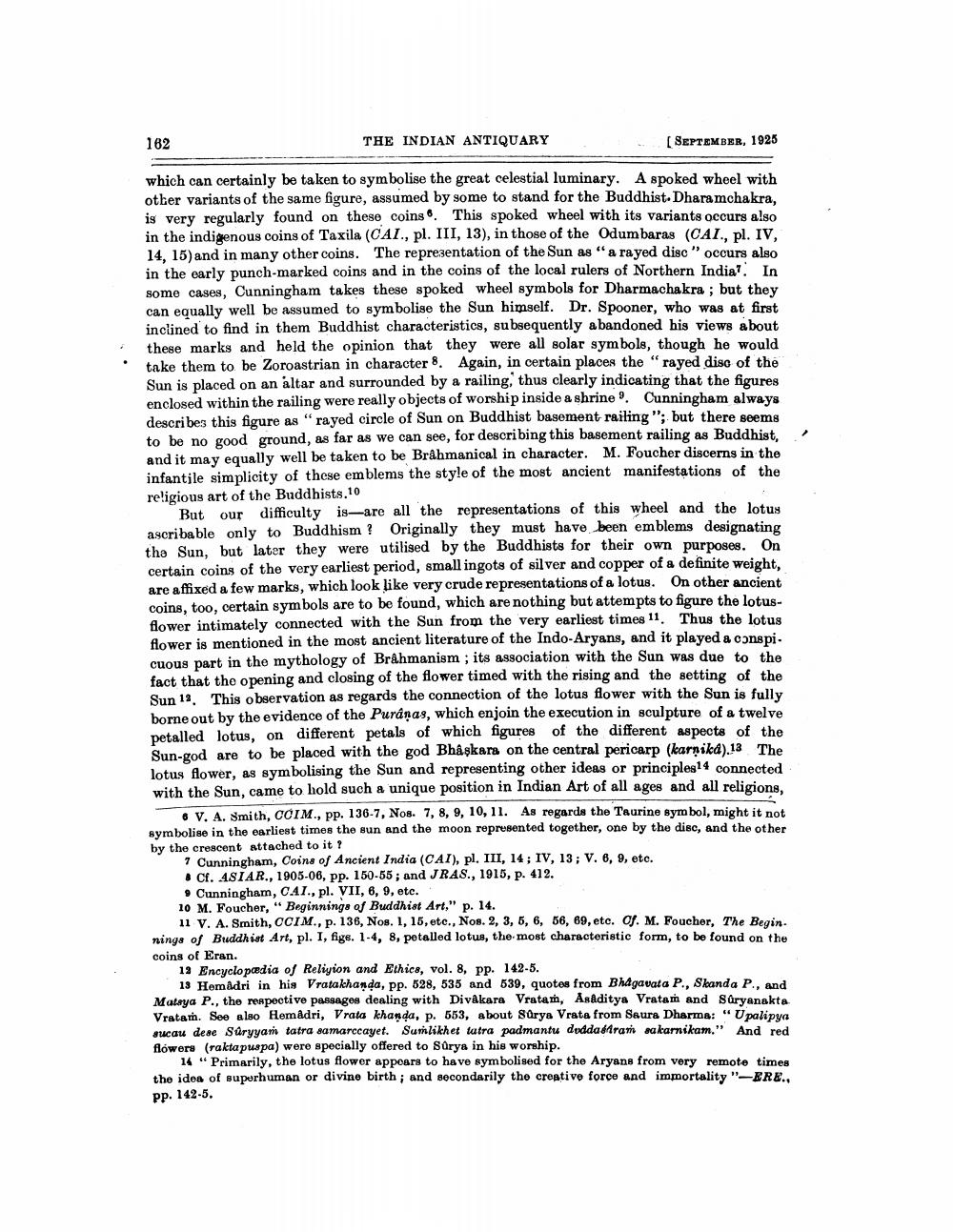________________
162
THE INDIAN ANTIQUARY
[ SEPTEMBER, 1925
which can certainly be taken to symbolise the great celestial luminary. A spoked wheel with other variants of the same figure, assumed by some to stand for the Buddhist. Dhara mchakra, is very regularly found on these coins. This spoked wheel with its variants occurs also in the indigenous coins of Taxila (CAI., pl. III, 13), in those of the Odum baras (CAI, pl. IV, 14, 15) and in many other coins. The representation of the Sun as "a rayed disc " occurs also in the early punch-marked coins and in the coins of the local rulers of Northern India? In some cases, Cunningham takes these spoked wheel symbols for Dharmachakra ; but they can equally well be assumed to symbolise the Sun himself. Dr. Spooner, who was at first inclined to find in them Buddhist characteristics, subsequently abandoned his views about these marks and held the opinion that they were all solar symbols, though he would take them to be Zoroastrian in character 8. Again, in certain places the “rayed diso of the Sun is placed on an altar and surrounded by a railing, thus clearly indicating that the figures enclosed within the railing were really objects of worship inside a shrine'. Cunningham always describes this figure as "rayed circle of Sun on Buddhist basement railing "; but there seems to be no good ground, as far as we can see, for describing this basement railing as Buddhist, and it may equally well be taken to be Brahmanical in character. M. Foucher discerns in the infantile simplicity of these emblems the style of the most ancient manifestations of the religious art of the Buddhists. 10
But our difficulty is-are all the representations of this wheel and the lotus ascribable only to Buddhism? Originally they must have been emblems designating tha Sun, but later they were utilised by the Buddhists for their own purposes. On certain coins of the very earliest period, small ingots of silver and copper of a definite weight, are affixed a few marks, which look like very crude representations of a lotus. On other ancient coins, too, certain symbols are to be found, which are nothing but attempts to figure the lotusflower intimately connected with the Sun from the very earliest times 11. Thus the lotus flower is mentioned in the most ancient literature of the Indo-Aryans, and it played a conspicuous part in the mythology of Brahmanism ; its association with the Sun was due to the fact that the opening and closing of the flower timed with the rising and the setting of the Sun 12. This observation as regards the connection of the lotus flower with the Sun is fully borne out by the evidence of the Puranas, which enjoin the execution in sculpture of a twelve petalled lotus, on different petals of which figures of the different aspects of the Sun-god are to be placed with the god Bhaskara on the central pericarp (karnikd).13 The lotus flower, as symbolising the Sun and representing other ideas or principles? 4 connected with the Sun, came to hold such a unique position in Indian Art of all ages and all religions,
6 V. A. Smith, CCIM., pp. 136-7, Nos. 7, 8, 9, 10, 11. As regards the Taurine symbol, might it not symbolise in the earliest times the sun and the moon represented together, one by the disc, and the other by the crescent attached to it?
7 Cunningham, Coins of Ancient India (CAI), pl. III, 14 ; IV, 13; V. 6, 9, etc. . Cf. 4SIAR., 1905-06, pp. 150-55; and JRAS., 1915, p. 412. 9 Cunningham, CAI., pl. VII, 6, 9, etc. 10 M. Foucher, " Beginnings of Buddhist Art," p. 14.
11 V. A. Smith, OCIM., p. 136, Nos. 1, 15, etc., Nos. 2, 3, 5, 6, 56, 69, etc. J. M. Foucher, The Begin. nings of Buddhist Art, pl. I, figs. 1-4, 8, potalled lotus, the most characteristic form, to be found on the coins of Eran.
12 Encyclopaedia of Reliyion and Ethics, vol. 8, pp. 142-5.
18 Hemdri in his Vratakhanda, pp. 528, 535 and 539, quotes from Bhagavata P., Skanda P., and Matsya P., the respective passages dealing with Divâkara Vratan, AsAditya Vratam and Saryanakta Vratan. See also HemAdri, Vrata khanda, p. 553, about Sarya Vrata from Saura Dharma: "Upalipya sucau dese Suryyan tatra samarccayet. Sunlikhet tatra padmantu doddadiran sakarnikam." And red flowers (raktapuspa) were specially offered to Surya in his worship.
14 Primarily, the lotus flower appears to have symbolised for the Aryans from very remoto times the idea of superhuman or divine birth, and secondarily the creative force and immortality "-ERE., pp. 142-5.




